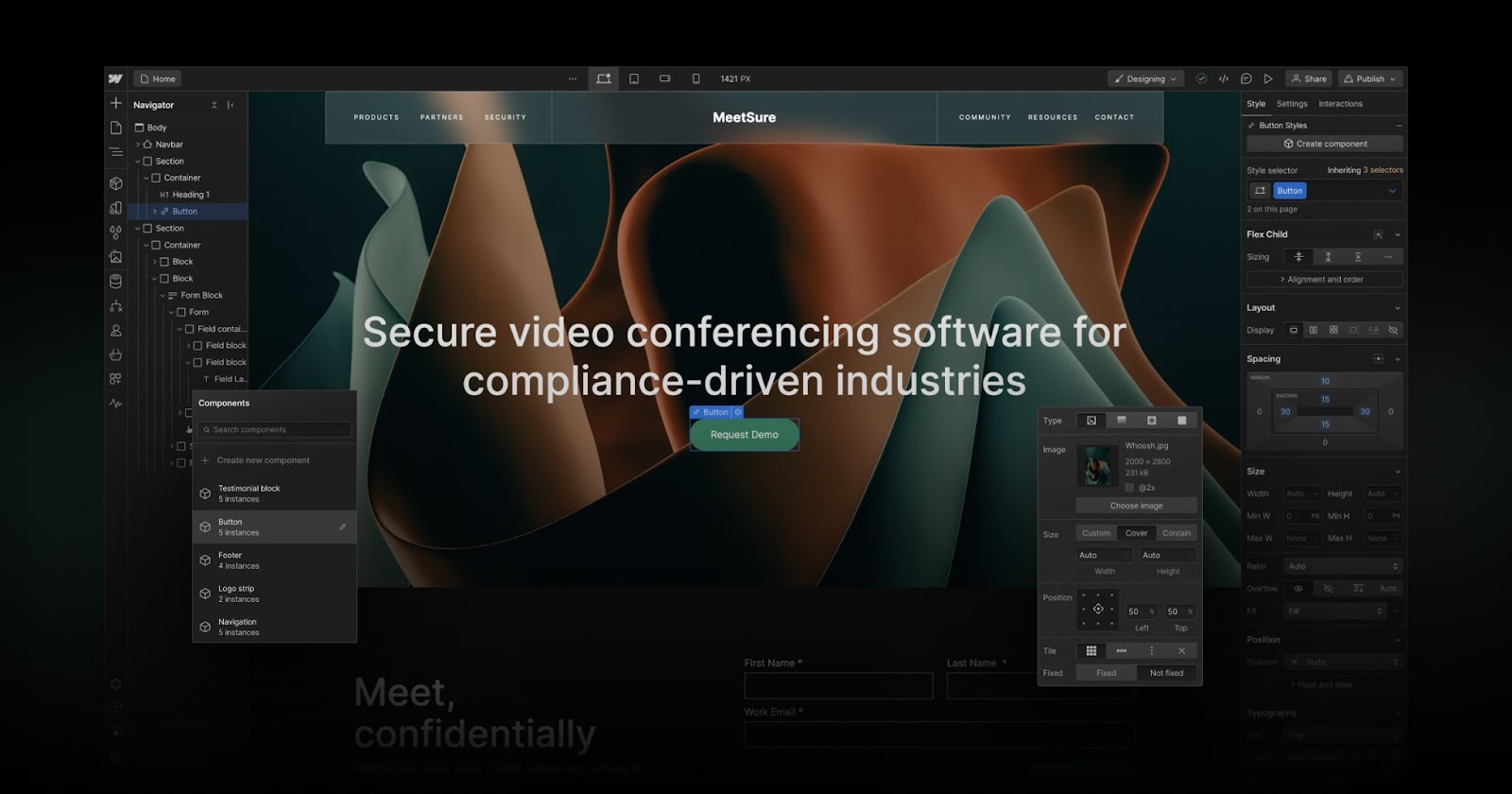Our view at Stack - Simplify web development with Webflow, reduce costs, and deliver professional results. No-code, responsive, and SEO-friendly. Explore your creative potential!

Project success fully depends on key stakeholders’ active engagement and support.
Every website project, from inception to launch, passes through numerous phases that require input from various contributors. These stakeholders typically include project managers, team members, and customers, and each brings unique perspectives and expertise. But bringing these parties together isn’t enough on its own.
With so many different individuals involved, understanding how to engage stakeholders is crucial. Their insights, feedback, and support are pivotal in navigating project challenges and unlocking new opportunities. This engagement ensures you consider different perspectives, enhances your decision-making, and aligns the project’s direction with broader organizational goals, steering it toward success.
Understanding stakeholder engagement
Stakeholder engagement is the process of actively involving individuals and groups who have a vested interest in a project’s outcome. This engagement goes beyond initial involvement and requires ongoing collaboration with key parties throughout the project’s lifecycle.
It requires collaborating with internal contributors, like project managers and team members, and involving external stakeholders, such as investors, sponsors, and customers. Their participation is vital because web development and design success depends as much on how well you understand, cooperate, and align with stakeholder interests and expectations as it does on technical skills and creative talent.
Engaging stakeholders effectively also fosters a sense of ownership, turning passive observers into active contributors. Starting this involvement early in the project builds trust, produces valuable feedback, and cultivates a positive, supportive environment. By taking this approach, you ensure the project benefits all involved parties and achieves its intended goals.
Types of project stakeholders
Of course, key project stakeholders vary between teams and industries. While the specifics differ, here are some of the most commonly involved types:
- Project managers. Project management oversees the project from planning to execution. They align the project’s objectives with the company’s long-term goals by coordinating tasks, managing resources, and ensuring timely, budget-conscious deliverables.
- Resource managers. These professionals manage and optimize human capital, materials, and budgets. They balance project demands with available resources to ensure smooth project progression.
- Team members. After project and resource managers set milestones and allocate resources, team members take over. When creating websites and apps, project teams typically include web developers, designers, and content creators who all collaborate on specialized tasks to bring the project to fruition.
- Executives and high-level management. Leaders at the executive and management levels provide strategic direction to align the project with the company’s mission and strategy. Their strategic input also opens doors to essential resources, enables higher-level approvals, and helps the project team navigate organizational hurdles — all to provide the project with necessary support.
- Sponsors. These stakeholders provide crucial financial and strategic project support. Whether internal or external, they focus on the project’s outcomes, like increased revenue or enhanced market presence. Their involvement brings significant value because they often have substantial resources and influence that you can leverage for project success. And their association with a successful project can enhance their market reputation, making it a symbiotic relationship for all parties.
- Customers. Customers are central to every project as the end users who buy into your company’s values and offerings. Catering to their needs and preferences, collecting feedback, and ensuring a positive experience are key to your project’s success.
6 effective stakeholder engagement strategies
After identifying the relevant stakeholders for your project, you’ll need to implement best practices to maximize output. Here are six practical strategies for stakeholder management and engagement.
1. Involve the right stakeholders
Actively map out the project’s scope and pinpoint areas that require specific expertise. Then, identify and engage individuals whose roles or interests directly impact the project’s outcome, including managers, executives, and customers.
Involving diverse stakeholders provides a broad spectrum of insights and ensures you integrate comprehensive perspectives into the project. Such an inclusive approach streamlines communication, reduces misunderstandings, and aligns the project with the organization’s goals.
In a website redesign project, you might include project managers to coordinate workflows and align tasks with the broader project goals. And executives such as department heads can offer strategic guidance to ensure the redesign aligns with the company’s vision. Involving customers, possibly through focus groups and surveys, provides direct insights into user preferences and needs. This collaboration ensures the redesigned website is user-centric, functionally sound, and seamlessly integrated with existing systems, fulfilling the organization’s specifications and objectives.
2. Identify needs and expectations
Conduct comprehensive analyses, like a competitor or stakeholder analysis, or specific, measurable, achievable, relevant, and time-bound (SMART) goal-setting to understand each stakeholder group’s ideal outcome. Consider leveraging surveys, interviews, and workshops to collect direct input and feedback. Doing so ensures you address each group’s concerns and priorities to drive more tailored and effective project outcomes.
When developing an ecommerce website, such analysis might reveal that user-friendly navigation and secure payment options are top priorities for your customers. Aligning these expectations with project objectives resonates with internal stakeholders like the marketing team, which values customer satisfaction, and the IT department, which prioritizes security. This alignment ensures the final product meets both internal objectives and user requirements, creating a well-rounded and successful outcome.
3. Communicate early and regularly
Early and ongoing communication is pivotal for stakeholder engagement. Initiating these dialogues at the project’s onset quickly addresses emerging concerns and keeps everyone on the same page. It’s important for alignment and adaptability because it allows the project team to respond swiftly to changing needs and feedback.
After establishing smooth communication lines, maintain the momentum by regularly updating stakeholders on progress and challenges. Consider using visual aids like wireframes and mockups to make complex concepts accessible to stakeholders, regardless of their technical expertise.
4. Seek feedback
Proactively seek stakeholder feedback and integrate suggestions throughout the project engagement. Taking this iterative approach demonstrates your commitment to meeting their expectations, lets you make timely adjustments, and helps you adapt to evolving project needs.
When creating a website, you might present stakeholders with interactive user interface prototypes and solicit their opinions on key elements like navigation, brand messaging, and overall functionality. Before the official launch, you can also use A/B testing to refine the site based on real users’ feedback. Leveraging feedback this way aligns the final product with stakeholder expectations and user needs and reinforces both groups’ involvement, making them feel valued and heard.
5. Stay ahead of market changes and trends
Regularly update stakeholders about market changes and emerging trends relevant to your project’s focus and industry. Keeping up with the latest developments in your niche helps you maintain a competitive edge and meet evolving user preferences, positioning you for long-term success.
To stay current, monitor industry publications through RSS feeds, participate in conferences and seminars, and engage with professional networks and social media. By incorporating up-to-date trends and advancements into your project, you ensure it reflects modern design preferences and cutting-edge functionality. Doing so enhances the project’s stakeholder appeal and resonates with end users, making it more relevant and attractive in a constantly evolving market.
6. Measure and modify stakeholder management strategies
Assess the effectiveness of your stakeholder engagement plan using key performance indicators (KPIs) and adjust them based on feedback and market dynamics. KPIs are essential because they provide quantifiable data that enables you to objectively measure the impact of your approaches. This objective measurement is vital for making informed decisions and fine-tuning strategies for better outcomes.
A relevant web design and development KPI is the project milestone completion rate. This metric measures the percentage of project milestones achieved within set time frames and factors in stakeholder collaboration. A lower-than-expected completion rate signals delays in receiving stakeholder feedback and approvals. To address this, you might need to enhance communication for timelier responses or recalibrate milestone deadlines based on realistic expectations.
To enhance this assessment, consider using data visualization tools like Google Analytics. Data visualization helps identify trends, patterns, and improvement areas, which is helpful for optimizing your strategies. You can use these data visualizations to simplify complex information and better communicate the insights to your project stakeholders. This clarity helps them grasp key points more effectively and enables smoother discussions and more informed decision-making.
If existing strategies aren’t providing optimal results or smooth workflows, consider tweaking them according to stakeholder preferences. For example, if investors prefer video calls over in-person meetings, switch to online collaboration tools for more effective engagement.
Implement stakeholder engagement strategies with Webflow
For a new website project plan to truly succeed, you need more than just a stakeholder engagement plan. You need the right web development and design tools to transform stakeholder ideas into reality.
Webflow Enterprise offers a visual web development platform for building dynamic, functional websites without relying on code. It enables real-time collaboration and design editing that allows for seamless collaboration with stakeholders regardless of location.
Whether you’re developing an ecommerce store or seeking creative inspiration for your next project, Webflow provides comprehensive tools for hosting, publishing, and securely maintaining your site.
If Webflow is of interest and you'd like more information, please do make contact or take a look in more detail here.
Credit: Original article published here.










































